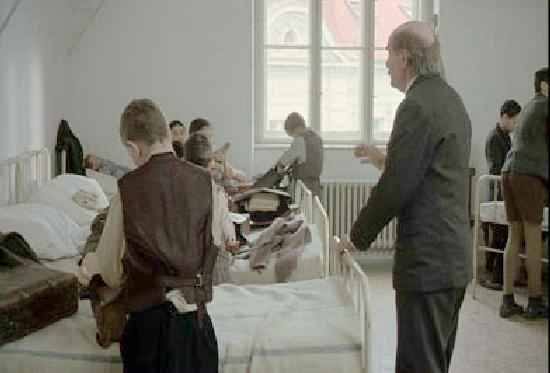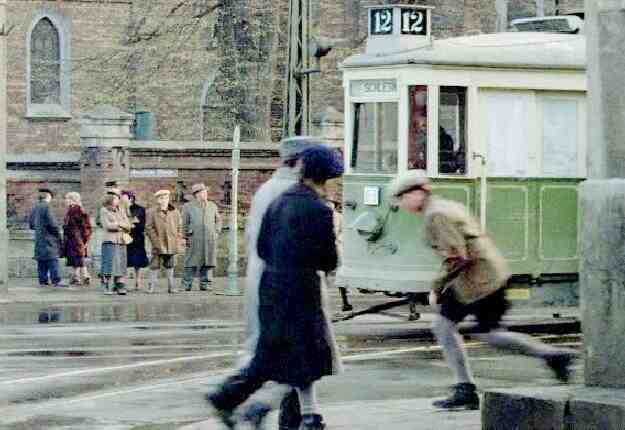
Uprising (U.S., 2001)

Figure 1.-- This scene shows Dr. Korczak with his orphan boys in the ghetto, an episode that can be interestingly compared with the Polish film, Korczak, directed by Andrzej Wajda, a scene from which I sent you recently and example. Here the boys are packing for their fatal train journey to the camp where they are to be murdered.
|
This 2001 American film is about he Jewish uprising in the Warsaw Ghetto during 1943. It was directed by Jon Avnet. It starred Jon Voight, Donald Sutherland and Cary Elwes and contains some historically accurate illustrations of boys' clothing. We have several images of the film. The movie is an absorbing dramatization of the Jewish uprising against their Nazi oppressers in the Jewish ghetto in Warwaw in 1943. The events of the story are quite true and quite harrowing. Jon Voight played Major-General Stroop, the Nazi commander and Cary Elwes played Dr. Fritz Hippler, a
propaganda civilian employed by the Nazis to make films showing the Jews to be
little better than vermin. Donald Sutherland plays the leader of the Jews in
the ghetto who is eventually forced to commit suicide. One scene shows Dr.
Korczak with his orphan boys in the ghetto, an episode that can be
interestingly compared with the Polish film, Korczak, directed by Andrzej
Wajda, a scene from which I sent you recently and example. Here the boys are
packing for their fatal train journey to the concentration camp where they are
slaughtered. Dr. Korczak is cheering them up and trying to get them to regard
the impending journey as a kind of adventure. The boys are dressed in the
same way as the boys in the Polish film and in fact the director may have
copied the clothing styles.
Filmology
It was directed by Jon Avnet.
Subject
This 2001 American film is about he Jewish uprising in the Warsaw Ghetto during 1943. The movie is an absorbing dramatization of the Jewish uprising against their Nazi oppressers in the Jewish ghetto in Warwaw in 1943. The events of the story are quite true and quite harrowing. Jon Voight played Major-General Stroop, the Nazi commander and Cary Elwes played Dr. Fritz Hippler, a
propaganda civilian employed by the Nazis to make films showing the Jews to be
little better than vermin. Donald Sutherland plays the leader of the Jews in
the ghetto who is eventually forced to commit suicide. One scene shows Dr.
Korczak with his orphan boys in the ghetto, an episode that can be
interestingly compared with the Polish film, Korczak, directed by Andrzej
Wajda, a scene from which I sent you recently and example. Here the boys are
packing for their fatal train journey to the concentration camp where they are
slaughtered. Dr. Korczak is cheering them up and trying to get them to regard
the impending journey as a kind of adventure. The boys are dressed in the
same way as the boys in the Polish film and in fact the director may have
copied the clothing styles. Note that the adolescent boy on the extreme right
wears short pants and light brown (or tan) long stockings like his counterpart
Szloma in the Korczak film (1990).
Cast
"Uprising" starred Jon Voight, Donald Sutherland and Cary Elwes.

Figure 2.--This street scene of Warsaw in the mid-1940s showing people waiting for the tram and a boy running to cross the street. The picture shows two adolescent boys--teenagers--dressed accurately for the period. The boy waiting with the other passengers in the background wears a flat cap, a light brown jacket that comes down over
his hips, brown knickers, and grey long stockings with hightop shoes. The other boy in the foreground wears a flat grey cap, a brown jacket, dark short pants, grey long stockings, and hightop shoes. The location is outside the Warsaw ghetto. Notice the church in the background.
|
Costuming
The fim contained some historically accurate illustrations of boys' clothing. We have several images of the film.
A Warsaw schoolboy (perhaps 12 years old) wearing a cap with a bill, a black overcoat (presumably over short pants), grey long stockings, high-top shoes, and carrying a leather bookbag or briefcase on his back attached by straps to his shoulders--a 1943 anticipation of the modern student's backpack. Another Warsaw boy wearing a similar cap, a single-breasted suit jacket, short pants, long grey stockings, and high-top shoes.
A market scene in 1939 Warsaw shows a boy ascending the stairs and carrying the tomato wears a peaked cap, what appears to be a dark sweater, shorts, ankle socks and high-top shoes. The boy attending the stand that sells leeks wears a tieless but buttoned-up shirt, a single-breasted tweed jacket, short pants, long stockings, and high-top shoes.
Here is a street scene showing the Warsaw tram with two different adolescent Polish boys in accurate period dress for the mid-and late 1940s. The boy waiting with the other passengers for the tram wears a flat cap, a winter jacket that comes down over his hips, brown knickers, and long grey stockings with hightop shoes. I think he is wearing a dark sweater underneath. The other boy, who is just running to catch the tram wears a flat
cap, a short jacket, dark short pants, long grey stockings, and hightop shoes. Both are good examples of teen-age boys' dress in 1940s Poland. Note that the boy running for the tram wears short pants with his long grey stockings instead of knickers. The distinction between knickers and short pants for adolescent boys seems to have had nothing
to do with age. The boys here are about the same age--probably 15 or 16, so
we see that short pants and knickers were about equally popular. Other shots
in the film would seem to confirm this equivalence.
Poland had the largest Jewish popularion in Europe with the exception of the Soviet Union. It was in Poland that mass murder of the Jews began and was perfected. The death camps were located in Poland not Germany. And in Poland the Germans found many willing to help them and few Poles intersted in protecting the Jews. Einsatzgruppen began killing Polish Jews with the German
invasion (September 1939). Most Polish Jews were forced into Ghettos. These ghettos were liuidated by the SS in 1942 following the Wannsee Conference: Lublin (March 1942); ghettos of Eastern and Western Poland (Spring 1942); and the Warsaw Ghetto (July-September 1942).
HBC

Navigate the Boys' Historical Clothing Web Site:
[Return to the Main movie "U" alphabetical page]
[Return to the Main movie page]
[Introduction]
[Activities]
[Biographies]
[Chronology]
[Clothing styles]
[Countries]
[Theatricals]
[Bibliographies]
[Contributions]
[Essays]
[FAQs]
[Glossaries]
[Satellites]
[Tools]
[Boys' Clothing Home]
Created: September 23, 2003
Last updated: October 4, 2003




